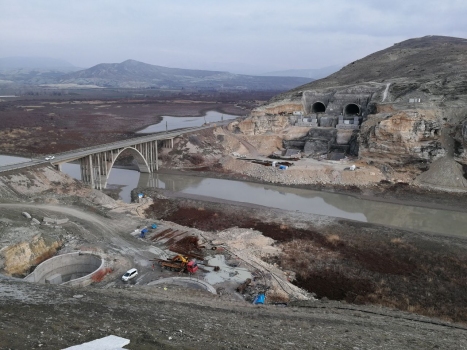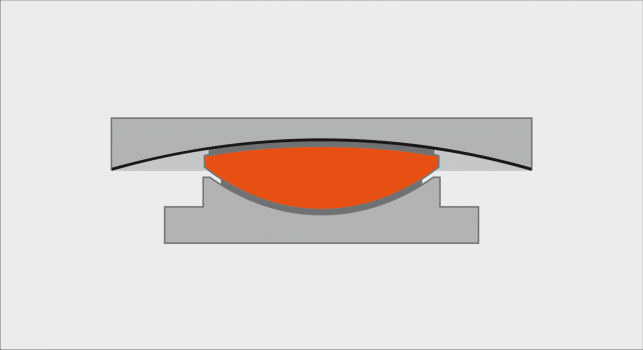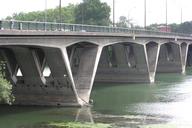Waterproof seismic protection for Çayırhan Bridge in Turkey
The Çayırhan Bridge crosses the Sariyar reservoir west of Ankara. Its pillars are periodically subjected to inundation. For the new bridge construction, large sliding isolation pendulums (SIP®) were designed, which have to fulfill three core tasks:
-
Ensuring full functionality at any time by preventing intrusion of dirt particles,
-
Accommodation of high loads exceeding 10,000 t and
-
Enabling service and seismic movements with a corresponding reduction of horizontal forces.
Media
The new Cayirhan Bridge is part of the expansion of the D140 Ankara-Nallihan-Yolu towards the highway. It is built next to the existing bridge and is situated at the upper end of the Sariyar reservoir where the River Sakarya temporarily becomes a lake due to backwater in the reservoir.
The new construction is a double bridge featuring a width of 13.5 m and a length of 270 m per driving direction. Each bridge has two base points with a distance of 176 m. From each base point, two concrete struts run with an upward incline and form a pedestal shaped like an inclined triangle. The heart of the bearing system are large SIP® bearings at the base points that may be inundated. In addition, flat sliding pendulum bearings are installed in the struts area and spherical bearings at the two abutments.
Completion scheduled for spring 2019
The large sliding isolation pendulums were installed in March 2018, further bearings are to follow, depending on construction progress, until the end of 2018. The Cayirhan Bridge with subsequent tunnel work is scheduled to be completed in spring 2019. The client is the regional highway direction section 4 Ankara.
High loads and inundation
The framework conditions for the SIP® bearings at the base points of the Cayirhan Bridge are defined by three aspects:
- Inundation
- Earthquake risk
- High structural load
For the earthquake load case, a structural load of 45 MN had to be considered and 101 MN for the ultimate load case (ULS).
To protect these bearings against pollution in case of inundation, they were equipped with a sophisticated circumferential protection ring made of 10 mm thick special chloroprene rubber. The rubber protection is a custom-built component from a company manufacturing such movable and watertight sheathings for use in the port area. The rubber ring features a curvature ensuring the mobility of the bearing.
Inundation also imposes special requirements on corrosion protection, since running water always carries small sand particles nibbling at the corrosion protection. This is why all bearing components not protected by the rubber sheathing were manufactured from stainless steel. The selected steel features the same solidity and load capacity but is corrosion-resistant.
Quadruple function in case of an earthquake
The SIP® bearings are designed to enable movements in all directions in case of an earthquake. Further specifications were free twisting capability of the bearings, 5.5 % friction and a 3.5 m radius.
This resulted in very large bearings with a diameter of 1.90 m, capable of accommodating the ultimate load of 101 MN.
The sliding bearings fulfill four tasks in case of an earthquake:
- They transfer vertical loads of up to 56 MN.
- They isolate the bridge deck from the foundation and allow for horizontal displacements of ±157 mm.
- They dissipate seismic energy through friction.
- They re-center the bridge superstructure to the center position after an earthquake thanks to the concavely curved sliding plate.
The single-sided movable sliding pendulum bearings contain a „calotte” as a tilting element with the upper surface slightly curved. This calotte is manufactured from a particularly corrosion-resistant metal alloy (MSA® – MAURER Sliding Alloy). In case of bridge movements, this calotte slides horizontally in the concave sliding plate with a pendulum motion, whereby the bearing automatically re-centers to the center position in an earthquake by storing potential energy.
The occurring sliding friction of 5.5 % acts like sort of a brake and ensures that the projected seismic movements of the superstructure are not exceeded. This horizontally flexible bearing function enables the reduction of the horizontal seismic loads by approx. factor 4 compared with a rigid retention.
Eight SIP® bearings have been installed, two at each base point. Due to the ultimate load, all of them have been designed for a bearing load of 101,857 kN.
Flat sliding bearings for longitudinal movements
In addition, the bearing system includes flat sliding bearings and spherical bearings. Both types are not subjected to inundation.
The eight flat sliding bearings allow for horizontal displacements on all sides and consist of a polyethylene disc sliding against polished stainless steel sheet. They are installed at the outer struts half way up. They are designed for a structural load of 36,690 kN and feature a diameter of about 1 m.
Spherical bearings for vertical forces
A special construction protects the bridge against uplifting forces. The bridge deck is connected to the abutment structure through a concrete cantilever. The abutment encircles the bridge cantilever like a claw.
In between, i.e. above and below the bridge cantilever, one spherical bearing each is installed. A total of 16 bearings accommodate the arising traction and pressure forces. They are designed for 21,654 kN each. In addition, they compensate for displacements of the bridge deck by means of an inner joint called calotte.
References
- About this
data sheet - Product-ID
7600 - Published on:
16/10/2018 - Last updated on:
16/10/2018





 MAURER SE
MAURER SE 

